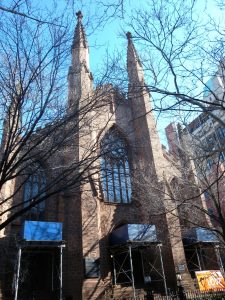
 The juxtaposition I chose for this project is located on 112 Pierrepont St. From City Tech you would walk to The Supreme Court. From there would walk down Pierrepont St. past the Brooklyn Historic Society. There you will spot a cathedral and a white building across the street from it. The juxtaposition is the old brick cathedral and the new marble building. The contrast between the two is that the cathedral is old fashioned and historic meanwhile the white building is has a more recent and modern feel to it. This white building is actually known as the Supreme Court of the State of New York : Appelate Division and the Cathedral is the First Unitarian Congregational Society in Brooklyn.
The juxtaposition I chose for this project is located on 112 Pierrepont St. From City Tech you would walk to The Supreme Court. From there would walk down Pierrepont St. past the Brooklyn Historic Society. There you will spot a cathedral and a white building across the street from it. The juxtaposition is the old brick cathedral and the new marble building. The contrast between the two is that the cathedral is old fashioned and historic meanwhile the white building is has a more recent and modern feel to it. This white building is actually known as the Supreme Court of the State of New York : Appelate Division and the Cathedral is the First Unitarian Congregational Society in Brooklyn.Another juxtaposition the two buildings share is their age. The Appelate Court was built in 1896, while the Congregational Society was built in 1833, making the Cathedral much older than the Court. If you look closely at the state of the two buildings you’ll notice that the Congregational Society looks remarkably older than the Appelate Court. It might’ve been renovated and kept in shape over the years. This contrast in particular reminds of the comparison of routes in the passage “What If You Could Choose Between the Fastest Route and the Most Beautiful”. When the narrator mentions the comparison of the two routes she says that “Mapping Apps are a fantastic tool, but they can be a little soulless.” So the narrator was saying the two routes were very different. The connection I made to my juxtaposition was that the fast route on a road may be boring and dull like the Congregational Society and the Scenic route on a road may be interesting and new like the Appelate Court.
I think that area in general will be drastically changed in the near future. Not too far from that location is a tall, new building that is currently undergoing renovation/construction. Another building that is on Fulton near Jay Street is also being built. The Macy’s building is also in the process of getting renovated. These are just a few examples of some of the different changes that have occurred in the Downtown Brooklyn area since the Construction of the Barclays Center. Ever since then, the area change dramatically new buildings were made and old locations were renovated. before long, It looked like a completely different location. If I wanted to take it further, my own neighbor hood is changing as well. There was a gas station a block away from where I live. One day, I noticed it was closed and over the years I also noticed that it was undergoing construction and eventually changed into a strip mall. Even Kings Plaza, which is not too far from where I live, was changed many stores were removed to make way for new ones and the ones that were still there were contemporized.



